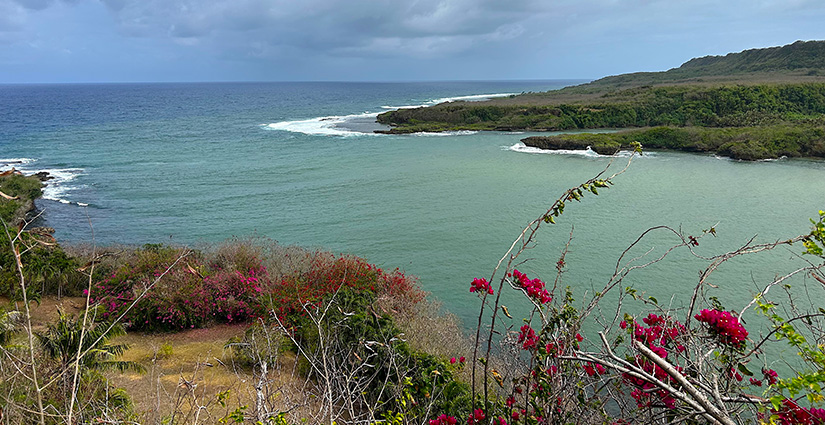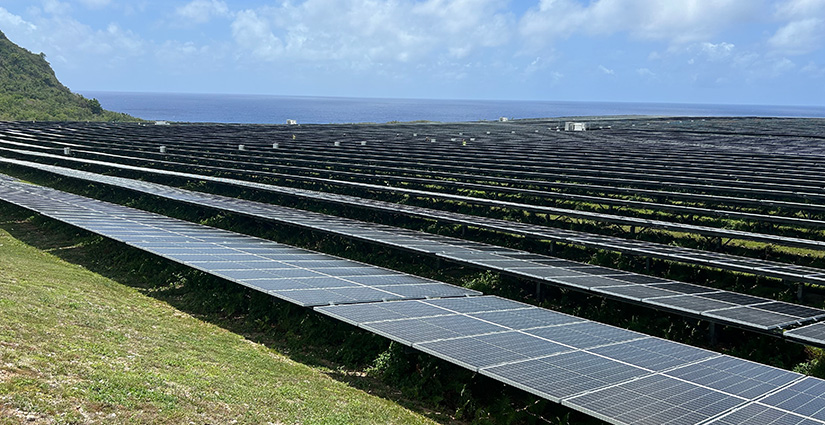How Will Guam Achieve 100% Renewable Energy by 2045?
Guam100 Will Help Determine Technical and Economic Scenarios Toward Attaining This Goal Affordably and Equitably

In August 2024, a group of Guam energy stakeholders and government leaders gathered to take another step toward a future in which the U.S. territory transitions to 100% renewable energy by 2045.
The stakes are high. Guam is primarily powered by expensive, imported fuel oil. The small territory (with a land mass about the size of Chicago) hosts three energy-intensive U.S. military bases due to its strategically advantageous location halfway between Hawaii and the Asian continent. Guam's residents shoulder a significant energy burden, with utility bills consuming a large portion of their incomes.
With funding from the U.S. Department of the Interior's Office of Insular Affairs (OIA), the National Renewable Energy Laboratory (NREL) is leading Guam100, providing decision support to inform investments to help the implementers of Guam's energy transition in their efforts to reach 50% electricity (based on sales) from renewable energy by 2035 and 100% by 2045. These renewable energy targets were established in 2019, when Guam's legislature passed Public Law 35-46, revising their previously legislated goals of up to 25% of electricity sales from renewable energy by 2035 upward. Currently, Guam receives about 13% of its energy from renewable energy, almost entirely solar power.
Through Guam100, NREL researchers are engaging key stakeholders and community representatives in the planning process and providing detailed technical analysis to help manage the challenges of interconnecting large amounts of inverter-based resources on Guam's electric grid.
Over the past several months, NREL has been working with Guam Power Authority to gather data on the current power system and better understand their goals for renewable energy development, in addition to talking with key stakeholders to understand their perspectives and concerns. The August meeting formally kicked off the Guam100 Advisory Group that will meet regularly to help inform the Phase 1 effort. The first order of business was to ensure the advisory group had engagement and representation from the governor's office, the mayor's council, and a broad range of local government agencies, higher education, large and small business groups, and community organizations. The Guam Energy Office provided support in organizing the group, and NREL hired a local consultant, Market Research & Development Inc., to handle logistics and meeting facilitation.
Researchers will use advisory group, stakeholder, and community feedback in conjunction with detailed power system modeling and analysis provided by NREL to inform development of alternative strategies for Guam to achieve 100% renewable energy. This will include analysis of technical challenges and solutions, technology options, and potential costs.
"We need to learn what the residents of Guam understand about renewable energy and what it will mean to them to achieve 100%," said Scott Haase, NREL laboratory program manager for partnership development. "Helping them see how Guam100 will benefit them, so they can get on board with this effort, will be critical to its success."
At the initial advisory group meeting, NREL set the stage for discussion by presenting baseline details on the current power system, equity and energy insecurity, and challenges to and opportunities for progress. Participants in the meeting were very engaged in the discussion and eager to contribute, representing a broad range of perspectives. In general, power stability was the biggest concern and affordability was the greatest hope for the transition to 100% renewable energy.

Mapping the Way to 100%
The goal of Guam100 is to inform the transformation of Guam's power system to equitable, resilient, and affordable 100% renewable energy while enhancing the reliability of the current grid. Guam100 takes an energy-justice-centered approach to its work that will engage local stakeholders to drive research teams and NREL analysis.
"From a technical perspective, it's not easy to get to 100% renewable energy, regardless of where you are," said NREL Senior Project Leader Phil Voss, who is leading the laboratory's Guam100 team. "In a remote location like Guam, affordability is paramount. From an energy security standpoint, maintaining the stability of the grid will be very, very important and will require new approaches to energy system planning, modeling, and operations."
Through Guam100, NREL will work to:
- Identify affordable, technically sound, resilient, and equitable pathways to achieve 100% renewable power—while enhancing the integrity of the electric grid.
- Conduct detailed technical analysis and modeling to determine how Guam can reach the goal of a power system using primarily renewable energy affordably, how much energy from renewable sources the existing Guam electrical grid can accommodate, and how the grid will need to change as it moves to integrating 100% renewable energy. Results from the power system modeling and scenarios supporting the transition will be published and shared publicly.
- Determine strategies for distributed energy, which generates electricity near where it will be used and avoids costly infrastructure.
- Develop and provide materials for community education on technical and economic considerations of various renewable energy technologies and energy transition strategies.
Building on a Long History of Support
NREL's Guam100 team will draw on the laboratory's extensive experience supporting island communities through OIA and other funders and with transitioning communities to higher usage of clean and renewable energy.
For the past 10 years, NREL has been at the forefront of developing advanced modeling and analytic frameworks to understand and communicate the technical, economic, social, and policy pathways to achieving clean electricity systems. Examples of this work include the Puerto Rico Grid Resilience and Transitions to 100% Renewable Energy Study and the Los Angeles 100% Renewable Energy Study.
NREL also has the benefit of learning from past and ongoing work in Guam, Hawaii, Puerto Rico, Alaska, the U.S. Virgin Islands, American Samoa, Northern Marianas, and similar locations. Recent work has included generating energy baseline reports (for American Samoa, the U.S. Virgin Islands, the Commonwealth of the Northern Mariana Islands, and Guam), assisting with energy security plans, and providing a variety of technical assistance on energy projects and programs for each of the U.S. territories.
For example, NREL recently helped the Guam Power Authority (GPA) with their large Phase IV solar energy and battery storage solicitation, providing technical assistance such as reviewing bids, providing detailed technical advice, and testing the bidder's models for grid forming inverter operation.
"GPA wanted to partner up with the national labs to provide independent scientific, engineering, and economic investigations by highly respected scientists and engineers for how GPA may proceed to implement 100% renewable energy for Guam," said John Cruz, GPA's assistant general manager of engineering and technical services. "This innovative, well-thought-out road map will seek wide partner participation, obtain feedback, answer relevant questions, and educate collaborators on the state of technology including GPA's current efforts." As an unbiased authority on renewable energy, NREL's neutrality is important in Guam100 and related efforts.
"We're not from the island, which means we can listen objectively to what the people of Guam have to say," Haase said. "Our research will also be objective, following science, engineering, and technical principles. In the end, we will communicate our results in a nontechnical way because it's important that people understand it."
The information resulting from this effort will help Guam energy stakeholders outline the transformation of Guam's energy system to 100% renewable energy.
"The future design of Guam's energy system, and how reliable electricity will be provided to everyone, will in the end be answered by the people of Guam," Haase said.
Learn more information about Guam100 and more about NREL's work with strategic partners like OIA.

